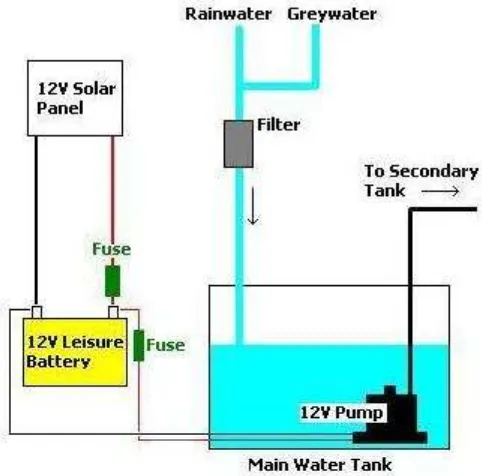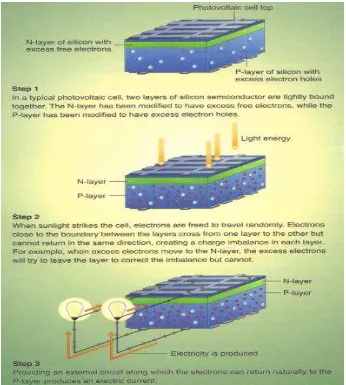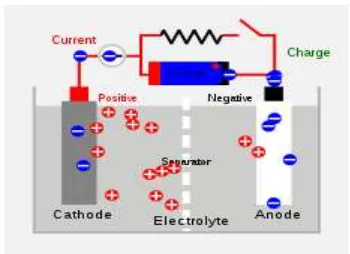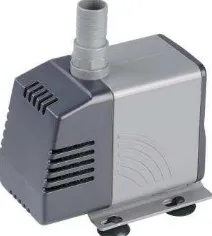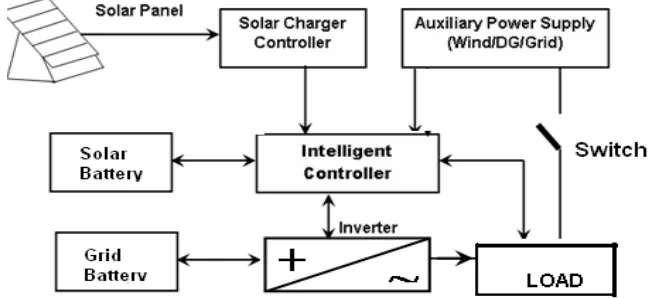FEASIBILITY STUDY OF GENERATING POWER FROM SOLAR ENERGY FOR IRRIGATION APPLICATION
MOHAMAD NUR ADLI BIN MOKHTAR
This report submitted in partial fulfillment of the requirements for the degree of Bachelor of Electrical Engineering (Industrial Power)
Faculty of Electrical Engineering
UNIVERSITI TEKNIKAL MALAYSIA MELAKA
I declared that this report entitle “Feasibility Study of Generating Power From Solar Energy For Irrigation Application” is the result of my own research except as cited in the references. The report has not been accepted for any degree and is not concurrently submitted in candidature of any other degree.
Signature : ……….
i
ACKNOWLEGDEMENT
I would like to express my appreciation and grateful thanks to my project supervisor, Mr. Alias b. Khamis for his kindness, trust and giving all the brilliants ideas in guiding me in completing this project. He also gives me the big valuable chance to do this project under his supervisory. His encourage, endless patience and cooperation that helps me to complete this report and project in time. I also would like to thanks to my parents and my family for their supports and encouragement. Without them, I feel lost in my life forever. Thanks dad and thanks mom for your support and have confidence in me since I was small.
ABSTRACT
iii
ABSTRAK
TABLE OF CONTENTS
CHAPTER TITLE PAGE
ACKNOLEDGEMENT i
ABSTRACT ii
ABSTRAK iii
TABLE OF CONTENTS iv
LIST OF FIGURES vi
LIST OF ABBREVIATIONS viii
LIST OF TABLE ix
1 INTRODUCTION
1.1 Project Background 1
1.2 Problem Statements 2
1.3 Objectives 2
1.4 Scope 3
2 LITERATURE REVIEW
2.1 Renewable Energy 4
2.2 Solar Energy 5
2.3 Irrigation Process 6
2.4 Charge Controller 7
2.5 Rechargeable Battery 9
2.6 Timer 10
2.7 Inverter 10
2.8 Water Pump 11
2.9 First Review 12
2.10 Second Review 12
v
3 METHODOLOGY
3.1 Introduction 15
3.2 Project Planning 15
3.3 Flow Chart 16
3.4 Project Methodology 17
3.5 Solar System Sizing Calculation 19 3.6 Software for Simulation Purpose 20 3.7 Designing and Simulating the Circuit 20
3.8 Project Development 22
3.9 Testing Procedure 25
3.10 Summary 25
4 RESULT AND ANALYSIS
4.1 Introduction 26
4.2 Simulation Result (Inverter) 27
4.3 Analysis Result 29
4.3 Test Result 29
4.5 Project Photo 32
4.6 Summary 33
5 DISCUSSION, RECOMMANDATION AND CONCLUSION
5.1 Discussion 35
5.2 Recommendation 36
5.3 Conclusion 36
5.4 Summary 37
REFERENCES 38
LIST OF FIGURES
FIGURE TITLE PAGE
1.1 Solar Powered Irrigation System 1
1.2 List of Project’s Component 3
2.1 Electricity Is Being Generate From PV Cells 6
2.2 12V 1A Charge Controller Circuit 8
2.3 Charging and Discharging Process 9
2.4 A 12V Rechargeable Battery 9
2.5 An Inverter Circuit 11
2.6 A Common 12Vac Water Pump 11
2.7 Block Diagram of Solar Power Supply 13
2.8 Power Module of Solar Power Supply 14
3.1 Project Planning 16
3.2 Flowchart of the Project 17
3.3 Block Diagram of a Solar Power Supply’s Operation 18 3.4 Block Diagram of a Conventional Power Supply’s Operation 18 3.5 Block Diagram of a Solar Power Automatic Water Pump 19
3.6 A 12V Charge Controller Circuit 21
3.7 An Inverter Circuit 21
3.8 PCB Design for Inverter Circuit 23
3.9 Inverter Circuit on PCB 23
3.10 Steps in PCB Etching Process 24
3.11 Soldering Components on PCB 24
4.1 Simulation of Inverter 27
4.2 Simulation of Inverter 28
4.3 Inverter Output Waveform 28
4.4 Adjusting Full Set-Point Battery 30
vii
4.6 Charge Controller Output 30
4.7 Inverter Output 31
4.8 Inverter Output (2nd test) 31
4.9 Inverter Output (3rd test) 32
4.10 Inverter Output (using multimeter) 32
4.11 Inverter Output (using multimeter 2nd test) 32
4.12 Circuit View in the UPS Box 33
LIST OF ABBREVIATIONS
A - Ampere
AC - Alternating Current
Ah - Ampere hour
DC - Direct Current
IC - Integrated Circuit
D - Diode
IEEE - Institute of Electrical and Electronics Engineering
F - Fuse
L.E.D - Light Emitting Diode
mAh - mili Ampere Hour
MOSFET - Metal Oxide Semiconductor Field Effect Transistor
NiCd - Nickel Cadmium
NiMH - Nickel Metal Hydride PWM - Pulse Width Modulation
PV - Photovoltaic Panel
Q - Transistor
R - Resistor
S - Switch
TM - Thermistor
TZ - Tranzorb
UTeM - Universiti Teknikal Malaysia Melaka
ix
LIST OF TABLE
TABLE TITLE PAGE
CHAPTER 1
INTRODUCTION
1.1 Project Background
Figure 1.1: Solar Powered Irrigation System
2
Solar ray that fall down into the atmosphere will hit the solar panel and produce electricity that will operate the charge controller to charge the rechargeable battery. Later the battery is fully charge and ready to operate when relay timer is counting down. This project will add a charge controller circuit, a relay timer and an inverter along with the original system which is rechargeable battery and a water pump.
1.2 Problem Statement
Nowadays, most of the process of power generation leads to pollution towards the environment. The common effects are acid rain, atmosphere haze, pollutes water resources and many more. It is because the power is being generated from the oil, natural gas, and coal. All this energy resource will contributes the environment pollutions whether being well process or not. In addition, this kind of energy sources is categorized as nonrenewable energy which is limited available sources. So, to overcome this pollution problem, we need to practice to use the renewable energy such as solar energy as optional energy sources. The solar energy is clean, renewable, and environment friendly. In this project, the solar energy will be use to generate electricity that drives the automatic water pump for irrigation process.
1.3 Objectives
Every single project needs objective to control the whole project tasks. A project is considered successful if the entire objective achieved. So, several objectives were established in completing this project. The objectives of this project are:
Design the automatic water pump for irrigation application powered by renewable energy (solar energy).
Develop a charge controller circuit and an inverter circuit in completing the automatic water pump for irrigation application.
The scope of this project is to develop an automatic solar power system for irrigation application. It will consist of several electronics components such as charge controller, inverter, timer and water pump as shown in Figure 1.2 below. Charge controller circuit will control the process of charging and discharging rechargeable battery while inverter circuit will convert the DC supply to AC supply. This project is getting power supply totally from the Sun and generates electricity to the water pump. So, several methods that suitable needed to make sure all the process run smoothly while developing the whole circuit.
4
CHAPTER 2
LITERATURE REVIEW
This chapter will discuss about the review of the past projects that related to this automatic solar power water pump for irrigation project and explanation of some the components that will use in completing the project. It also consists of the basics theory which is understandable while doing the project. The part that will be discussing in this chapter is renewable energy, solar energy, irrigation process, charge controller, rechargeable battery, timer, inverter and water pump.
2.1 Renewable Energy
The most abundant sources of renewable energy are solar energy. Solar energy is the radiant light and heat from the Sun that has been harnessed by humans since ancient times using a range of ever-evolving technologies. Like any source of energy, solar energy also has advantages and disadvantages on its own. But, it is ubiquitous, clean and inexhaustible [3]. Solar energy can generate electricity without harmful emissions and combustion [3]. A study shows that more solar energy falls to the earth than the other inhabitant planet. The geographical location, time of day, season and light also affect the total of the solar radiation that can be use for electricity. Solar energy technologies have made huge cost improvement but they still more expensive than traditional energy sources. There are three types of solar radiation which is direct radiation, diffuse radiation and albeldo radiation.
Solar energy system use either solar cell or some form solar collector to generate electricity. The primary of the solar energy technology for power generation is photovoltaic (PV). This kind of cell consists of layers of silicon that have different properties. There are several types of solar cells:
crystalline silicone thin film
nonsilicon compound thin film nano-crystalline
fullerene
6
Figure 2.1: Electricity Is Being Generate From PV Cells
2.3 Irrigation Process
The aim of this project is to achieve the water pump flow the water to the crops or plants. This kind of process called irrigation process. Irrigation is an artificial application of water to the soil. It is usually used to assist in growing crops in dry areas and during periods of inadequate rainfall. There are several types of irrigation process like surface irrigation, localize irrigation, drip irrigation, sprinkler irrigation, center pivot irrigation, lateral move irrigation, and sub-irrigation and many more.
was being improved by placing a component called timer. The function of timer is to run the irrigation process automatically. As a result, the cost of employee will be reducing because the all the irrigation process is automatic and no need an extra employee to run the irrigation process.
2.4 Charge Controller
The main function of charge controller is to control the rate of rechargeable battery charging process. It is also known as charge regulator or battery regulator. It will prevent overcharging and may prevent against overvoltage, which can reduce the battery lifespan and performance. Electronic circuitry in regulator measures battery voltage, which rise as the battery state-of-charge increase. At some voltage which is different depends on the types of batteries at different temperature, the regulator in charge controller circuit will limit the charging process to the battery. Charge controller circuits are used for rechargeable electronic devices such as cell phones, laptop computers, portable audio players, and uninterruptible power supplies, as well as for larger battery systems found in electric vehicles. Figure 2.2 below shows the charge controller circuit that will be use in this project. The circuit was being modified by increase the load dump resistor value up to 20ohm 20W to meet the requirement of the current rating of circuit which is 1A. The dump load resistor 68ohm 3W rating only suitable for the low current application.
8
Figure 2.2: 12V 1A Charge Controller Circuit
The 2N3906 transistor is wired with a zener diode in its base circuit, when the PV voltage is above 12V; the 2N3906 transistor turns on and enables the comparator circuit. The upper half of the TLC2272 op-amp inverts the dump load control signal, this is used to power the high intensity red LED. The LED turns on when the battery reaches the full setpoint. The LED does not waste any useful charging power since it only turns on when the battery is full. The 78L09 IC provides 9V regulated power to the comparator circuitry. Operational power for this circuit is provided entirely from the PV panel, so there is virtually no power taken from the battery at night.
Rechargeable battery (also known as a storage battery) is a group of one or more secondary cells. Rechargeable batteries use electrochemical reactions that are electrically reversible. Rechargeable batteries come in many different sizes and use different combinations of chemicals. A charge controller circuit needed to control the charging and discharging process of rechargeable battery. Figure 2.3 shows the graphical picture of charging and discharging process. During charging, the positive active material is oxidized, producing electrons, and the negative material is reduced, consuming electrons. These electrons constitute the current flow in the external circuit. The electrolyte may serve as a simple buffer for ion flow between the electrodes, as in lithium-ion and nickel-cadmium cells, or it may be an active participant in the electrochemical reaction, as in lead-acid cells.
Figure 2.3: Charging and Discharging Process
There are several types of rechargeable battery like Nickel-Metal Hydride Battery (NiMH), Nickel Cadmium Battery (NiCd), Lithium-ion Battery, Lithium sulfur battery, Thin film battery and Carbon foam-based lead acid battery. Figure 2.4 show the example of the rechargeable battery that been use in completing this project.
10
2.6 Timer
A timer is a specialized type of clock. A timer can be used to control the sequence of an event or process. It works reverse in direction compared to the stopwatch. Whereas a stopwatch counts upwards from zero for measuring elapsed time, a timer counts down from a specified time interval, like an hourglass. Timers can be mechanical, electromechanical, electronic (quartz), or even software as most computers include digital timers of one kind or another. In this project, the mechanical or electronic timer probably uses to complete this circuit. The timer has a control relay or contactor build in it. Control relay or contactor is an electromechanical device which activates one or more switches according to the current through a coil not connected to the switches. A relay is essentially an electromagnet with two possible states arranged so that when there is sufficient current the core of the relay's coil attracts a ferromagnetic armature which mechanically operates switches; a spring holds the armature away from the core when not actuated. The spring is designed to snap the contacts between two stable mechanical states; there should not be a range of coil current which allows the contacts to be in an intermediate state.
2.7 Inverter
Figure 2.5: An Inverter Circuit
2.8 Water Pump
In this project, a 240Vac water pump will be used to flow the water in completing the irrigation process. There are several types of water pump available in market depend on the requirement of the user. For this project, only common water pump needed that can supply water from a tank to the crops or plant next to the pump. So, the decision is to use the water pump that being commonly use in aquarium fish tank to circulate the water. The cost will be cheap and easy to get in market. Figure 2.6 shows the sample of water pump at the local market.
12
2.9 First Review: Study on Portable Power Supply Equipment Using The Flexible Solar Cell Sheet (By Sonoda Toshiaki, Iguchi Yoshio, Yonemochi Shigenobu, 1995-1997) [11]
The article describes about study on portable power supply equipment which carried out in 1995-1997. This study aim at obtaining the technical data for realizing portable power supply equipment using the solar cell as a source of energy which is used as a power supply for the field and which is excellent in maintenance, supply, and secrecy, and does not have noise, and exhaust gas and exhaust heat.
The equipment consists of the amorphous silicon solar cell module covered by the surface protection film processed with the sand mat, the lithium ion secondary battery, and the charger. The result of this study is as follows:
a) The solar cell module were the unfolding condition size
900mm*600mm*1.5mm, the folding condition size 180mm*300mm*20mm, the weight of 440g, the maximum output of 22W, the surface reflectance of maximum of 2%, and the conversion efficiency of 5.8%.
b) The secondary battery and the charger were able to be charged even if the output of the solar cell module changed (14V-20V).
2.10 Second Review: Solar Electricity in Rural Villages (By S.N. Singh, A.K. Singh, 2009) [10]
This paper presents the development of a solar power converter for a rural house to meet the additional electrical energy demand which is increasing day by day due to rapid growth of population. A prototype sample has been constructed to explore the feasibility of developing such system to work as a supplementary source.
household loads.
The total load(s) are divided into two category namely critical and heavy duty loads. The critical load(s) are prioritized to match with the availability of power sources whereas balance loads are connected together and powered through auxiliary sources. A study on socio-economic impact has been carried out and found to give encouraging results.
Figure 2.7: Block Diagram of Solar Power Supply
The primary source is obtained from auxiliary sources such as wind grid, DG etc where as the supplementary source is obtained from PV source. The consistency in supply to load is obtained either directly through grid or by grid battery during grid failure .The photovoltaic cell, popularly known as solar cell (plate), converts solar energy into DC electricity.
